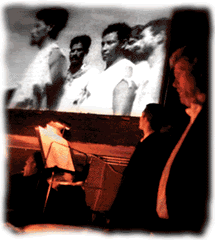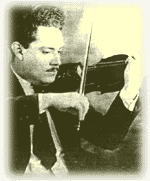Revealing A Lot About Revueltas
By Mark Swed

The festival was a centennial celebration of a great Mexican composer, born on the last day of the 19th century, whose voice has only recently become widely heard. A Grammy-nominated recording of Revueltas’ music by the Los Angeles Philharmonic and Esa-Pekka Salonen is helping, but there is still much to learn about this composer who filtered indigenous Mexican musics through a dazzling modernist sensibility.”

Even a brief visit to the festival Sunday for its last two concerts was enough to reveal just how remarkable a figure Revueltas was. Among Revueltas’ great achievements was his film music, although the 10 films he scored are virtually unknown in America. His first, “Redes” (Nets), is a classic, but even that is rarely seen. It was shot in Mexico in 1934 by photographer Paul Strand and co-directed by a young Fred Zinnemann (of “High Noon” fame) and Emilio Gomez Muriel. Revueltas’ score to it is mainly known through a suite made by the great Austrian conductor Erich Kleiber.

It was also Ben-Dor’s intention to place Revueltas within a larger context of major Latin American musical statements, and for the first half of the concert, she retrieved an amazing one, Villa-Lobos’ massive Symphony No. 10 (“Amerindia”). This is the monster of Villa-Lobos’ 11 symphonies, and Ben-Dor’s performance was its U.S. premiere.
“Amerindia” lasts nearly an hour; it requires a huge orchestra, a large chorus and vocal soloists. Written in 1952 for the 400th anniversary of the founding of Sau Paulo, the symphony attempts to grasp four centuries of Brazilian culture and myth through a host of musical styles, and as so often is the case in Villa-Lobos, Afro-Brazilian rhythms cozy up to Bach. There are pages of text in Latin, modern Portuguese and the Tupi dialect. Magical monkey legends here; Marian poems there. The second part of the five-part symphony is a war cry. The last ends with a great, inspiring Alleluia.
It is hard to know what to make of it all. Villa-Lobos’ flair for the dramatic pulls one in, but he doesn’t always work at the same level of inspiration. It was even harder to know what to make of it from this performance. Ben-Dor is an enthusiastic, forceful conductor, but her industry isn’t matched by her resources. The Santa Barbara Symphony, the various choruses and soloists (tenor Carlo Scibelli and bass Nmon Ford Livene) all struggled valiantly. It was also a problem for the audience not to be able to follow the text, printed in tiny type, in a very darkened hall.
Sunday evening, Ben-Dor presented a different sort of context, this time with Santa Barbara Chamber Orchestra playing Revueltas, followed by mostly Latin American percussion music by the Tambucio Percussion Quartet of Mexico, at the Santa Barbara Junior High School Auditorium.
The chamber orchestra proved on even shakier ground than its big brother. Still, one got the point with the US premiere of “Cuauhnahuac” in its string orchestra version. Written in 1931, this is Revueltas’ first major score, and it is an early, mostly successful, attempt to mix cultures, that finds similarities in pre-Hispanic and modernist musics but also has great fun exploiting their jolting differences. Seven years later, in “Troka” and “Musica Para Charlar” (“Chit-Chat Music”), which followed on the program, Revueltas had found a hundred frisky, entertaining and inventive ways to accomplish that.
The Tambuco had less interesting music to play. These percussion pieces were often just extensions of a single notion, tapping on a table or, in Colombian composer Leopoldo Novoa’s “Sabe como e’?” (You Know What I mean?) rasping on guacharacas . But here the virtuosity and theatricality of the players compensated. Put Ben-Dor and her enthusiasms together with players of this caliber and Santa Barbara could really produce a world-class festival.
